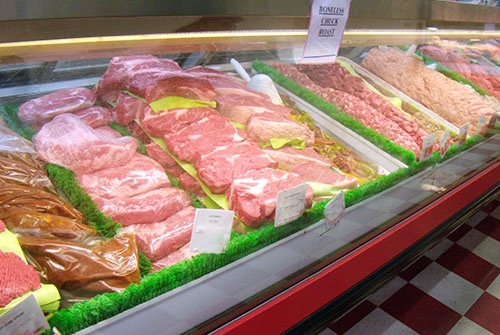Explore the Local Taste at Bagley Farms Meat Market Edwardsville IL: Fresh and Delicious
Explore the Local Taste at Bagley Farms Meat Market Edwardsville IL: Fresh and Delicious
Blog Article
Reveal the Art of the Butcher's Cut in a Modern Meat Market
In the ever-evolving landscape of modern meat markets, the butcher's cut has actually transcended its typical roots, combining old-time workmanship with modern techniques. What genuinely sets the modern-day butcher apart is their ability to build a deeper link in between customers and the origins of their meat.
Advancement of Butchery Techniques
The advancement of butchery techniques shows a rich tapestry of technology and adaptation driven by developments in modern technology, changes in customer demand, and a deeper understanding of meat scientific research. Historically, butchery was a craft passed down with generations, with approaches refined over centuries to maximize yield and taste. The industrial change ushered in automation, transforming typical practices and allowing massive handling.
The mid-20th century saw butchery strategies further refined by clinical understandings into muscle biology and meat aging, improving both tenderness and preference. Technologies like vacuum cleaner packaging and refrigeration extended product shelf-life, enabling butchers to diversify offerings and boost quality control. This period additionally noted the surge of specific tools, such as band saws and meat slicers, which raised precision and efficiency in meat processing.

Computerized systems now help in monitoring animal provenance and enhancing cuts to satisfy certain consumer preferences. In addition, a renewal in artisanal butchery has emerged, mixing conventional skills with modern-day expertise to cater to customers looking for ethical and lasting meat options.
Recognizing Meat Cuts
Understanding the complexities of meat cuts is vital for both butchers and customers looking for high quality and worth. For butchers, precise cuts show skill and respect for the craft, guaranteeing minimal waste and ideal yield.

Understanding muscle composition is critical; muscles made use of much more regularly by the animal have a tendency to be tougher and are best suited for slow cooking methods, while less-used muscular tissues, like those located in the loin, are more tender and ideal for cooking or roasting. Experience with these differences encourages consumers to make educated selections, enhancing their culinary endeavors.
Selecting High Quality Meat
Choosing the right meat involves more than just selecting a visually attractive item from the display. The art of picking top quality meat needs a discerning eye and knowledge of details features that represent freshness and excellence.
Secondly, take into consideration the marbling, which refers to the white streaks of fat within the muscle mass. Appropriate marbling is a vital indicator of inflammation and flavor, as it thaws throughout cooking, improving the meat's juiciness. Bear in mind, greater marbling commonly associates with exceptional top quality cuts, such as USDA Prime.
Texture is an additional important aspect; meat should feel strong to the touch, not slimy or extremely soft. Furthermore, bear in mind the fragrance. Fresh meat ought to have a tidy, find out this here neutral scent, devoid of any type of sour or repulsive odors.
Matching Cuts With Food Preparation Techniques

Conversely, Bonuses harder cuts like brisket and chuck roast are rich in collagen, which breaks down into jelly when cooked slowly. These cuts are ideal for braising or slow roasting, permitting the meat to soften gradually and establish deep, intricate tastes. Cuts such as short ribs and pork shoulder make out well with slow-cooking approaches, where extended cooking times transform their robust textures right into delicious meals.
Lamb shanks and oxtail, which require long term food preparation to soften, are ideal prospects for cooking or sluggish simmering. These techniques coax out rich, passionate tastes while keeping wetness. By understanding the special characteristics of each cut, chefs and home chefs alike can raise their culinary developments, ensuring each recipe is both pleasing and unforgettable.
The Butcher's Function Today
Browsing the advancing landscape of the modern meat market, the butcher's duty today expands past plain prep work of cuts. Contemporary butchers are culinary craftsmens, teachers, and supporters for sustainable practices. They link the void in between the farm and the fork by guaranteeing ethical sourcing, recognizing animal husbandry, and prioritizing transparency in the supply chain. This shift shows the expanding consumer demand for high quality over amount, where provenance and pet well-being are paramount.
In addition to crafting exact cuts, butchers now involve straight with consumers, providing cooking suggestions and tailoring choices additional hints to suit specific needs and choices. Their know-how in meat aging, marbling, and taste accounts encourages consumers to make informed decisions, enhancing their culinary experiences. This individualized service exemplifies the butcher's developing function as a trusted advisor in the kitchen.
Moreover, butchers are crucial in minimizing waste, using whole pets to develop diverse items such as sausages and supplies. This extensive strategy not only respects the pet yet additionally straightens with contemporary sustainability goals. In this method, the modern butcher personifies both practice and innovation, adjusting to an ever-changing market while protecting the artistry and honesty of their craft.
Verdict
Mastery in recognizing diverse meat cuts and top quality indications empowers butchers to supply enlightened referrals, aligning particular cuts with ideal food preparation approaches. By honoring historic practices while embracing modern needs, the butcher's function continues to be crucial in today's advanced meat market.
Report this page